Related Research Articles
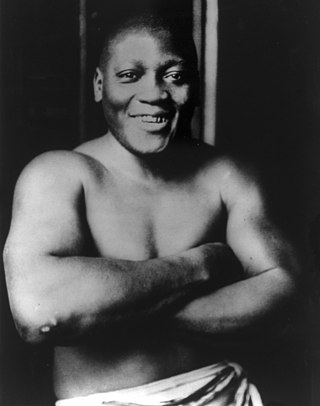
John Arthur Johnson, nicknamed the "Galveston Giant", was an American boxer who, at the height of the Jim Crow era, became the first black world heavyweight boxing champion (1908–1915). His 1910 fight against James J. Jeffries was dubbed the "fight of the century". Johnson defeated Jeffries, who was white, triggering dozens of race riots across the U.S. According to filmmaker Ken Burns, "for more than thirteen years, Jack Johnson was the most famous and the most notorious African American on Earth". He is widely regarded as one of the most influential boxers in history. Transcending boxing, he became part of the culture and history of racism in the United States.
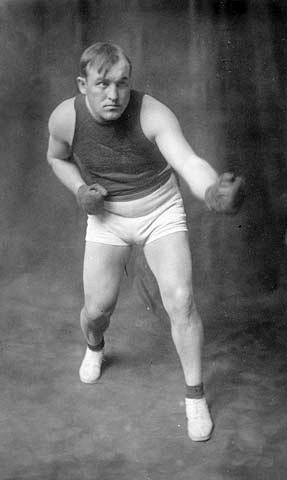
Tommy Burns was a Canadian professional boxer. He is the only Canadian-born World Heavyweight Boxing Champion. The first to travel the globe in defending his title, Burns made 13 title defences against 11 different boxers, despite often being the underdog due to his size. Burns took on all challengers as Heavyweight Champion, leading to his legendary bout with the African American Jack Johnson. According to his biographer, Burns insisted, "I will defend my title against all comers, none barred. By this I mean white, black, Mexican, Indian, or any other nationality. I propose to be the champion of the world, not the white, or the Canadian, or the American. If I am not the best man in the heavyweight division, I don't want the title."

Joseph Louis Barrow was an American professional boxer who competed from 1934 to 1951. Nicknamed "The Brown Bomber", Louis is widely regarded as one of the greatest and most influential boxers of all time. He reigned as the world heavyweight champion from 1937 until his temporary retirement in 1949. He was victorious in 25 consecutive title defenses, a record for all weight classes. Louis had the longest single reign as champion of any boxer in history.

Maximilian Adelbert Baer was an American professional boxer and the world heavyweight champion from June 14, 1934, to June 13, 1935. He was known in his time as the Livermore Larupper and Madcap Maxie. Two of his fights were rated Fight of the Year by The Ring magazine. Baer was also a boxing referee, and had occasional roles in film and television. He was the brother of heavyweight boxing contender Buddy Baer and father of actor Max Baer Jr. Baer is rated #22 on The Ring magazine's list of 100 greatest punchers of all time.
Boxing in the 1920s was an exceptionally popular international sport. Many fights during this era, some 20 years away or so from the television era, were social events with many thousands in attendance, both men and women.

Samuel Edgar Langford was a Canadian boxing standout of the early part of the 20th century. Called the "Greatest Fighter Nobody Knows", by ESPN, Langford is considered by many boxing historians to be one of the greatest fighters of all time. Originally from Weymouth Falls, a small community in Nova Scotia, he was known as "the Boston Bonecrusher", "the Boston Terror", and his most famous nickname, "the Boston Tar Baby". Langford stood 5 ft 6+1⁄2 in (1.69 m) and weighed 185 lb (84 kg) in his prime. He fought from lightweight to heavyweight and defeated many world champions and legends of the time in each weight class. Considered a devastating puncher even at heavyweight, Langford was rated No. 2 by The Ring on their list of "100 greatest punchers of all time". One boxing historian described Langford as "experienced as a heavyweight James Toney with the punching power of Mike Tyson".

James Jackson Jeffries was an American professional boxer and world heavyweight champion.
Marvin Johnson is an American former boxer who was a 3-time light-heavyweight champion of the world. As an amateur, Johnson fought in the 1972 Olympics in Munich, winning a bronze medal, and made his way up the professional ranks in the light heavyweight division soon thereafter. Johnson was inducted into the World Boxing Hall of Fame in 2008 alongside Lennox Lewis and Pernell Whitaker. His nickname is "Pops".
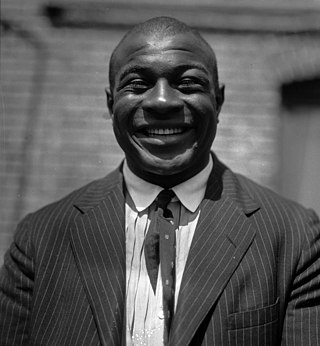
George Godfrey (II) The Leiperville Shadow was the ring name of Feab Smith Williams, a heavyweight boxer from the state of Alabama who fought from 1919 to 1937. He named himself after George "Old Chocolate" Godfrey, a Black Canadian boxer from the bare-knuckle boxing days who had been a top name during the John L. Sullivan era. Old Chocolate had been the fourth fighter to reign as World Colored Heavyweight Champion while the second George Godfrey was the 20th fighter to hold the colored heavyweight title.

Luther Quinter McCarty was an American professional boxer who competed from 1911 to 1913. He was considered by most to be the greatest of all the "Great White Hope" fighters who fought during the time of Jack Johnson. He claimed the Heavyweight Championship during Jack Johnson's troubles with the United States Government, with many boxing historians rating him the man with the best chance of defeating Johnson. McCarty was ranked #10 on The Ring magazine's list of the best American heavyweights of the 1910s.
The World Colored Heavyweight Championship was a title awarded to black boxers in the late nineteenth and early twentieth centuries. This was the only recognized heavyweight championship available to black boxers prior to Jack Johnson winning the world heavyweight title in 1908. The title continued to exist until the reign of Joe Louis as universally recognized champ, as the color bar against black heavyweights was enforced during and for a generation after Jack Johnson's reign as world champ.

Kid Norfolk was an American professional boxer who fought as a Light Heavyweight and Heavyweight from 1910 through 1926, holding wins over many notable boxers of his day including Joe Jeanette, Billy Miske, Jack Blackburn, Harry Greb, Tiger Flowers, Battling Siki, and Gunboat Smith. Norfolk was inducted into the International Boxing Hall of Fame in 2007.

Bill Lang was an Australian professional boxer who held the national heavyweight title. He was also an Australian rules footballer who played with Richmond in the Victorian Football League (VFL).

Bob Armstrong, was a heavyweight boxer known as the "King of the Battle Royal". He was born in Rogersville, Tennessee, but he moved with his family to Washington, Ohio when he was three years old.
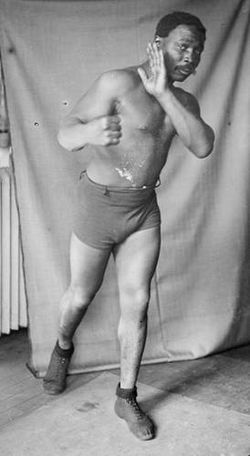
Frank Childs, "The Crafty Texan", was an African American boxer who fought professionally out of Chicago from 1892 to 1911 and twice held the World Colored Heavyweight Championship. Fighting at a weight of between 160 and 185 lbs., the short, stocky Childs fought middleweights, light-heavyweights and heavyweights. He had a powerful punch.
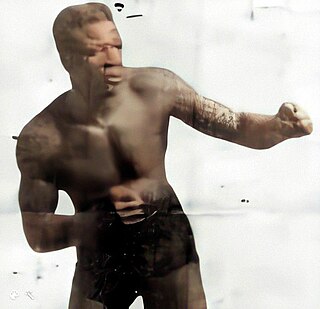
Klondike Haynes was an African American boxer billed as "The Black Hercules" who declared himself the black heavyweight champion. Born John Haines or John W. Haynes, the 6-foot (1.8 m) tall Klondike fought out of Chicago as a heavyweight at a weight of 190–200 pounds (86–91 kg) from 1898 to 1911. He took the nickname because he was supposed to be a great find.

Arthur Pelkey was a Canadian boxer who fought from 1910 to 1920. Born Andrew Arthur Pelletier in Pain Court, Ontario, the 6′ 1½″ Pelkey fought in the heavyweight division at a weight of between 206 and 210 lbs. He was one of the "White Hopes" of the time that African American Jack Johnson was the world heavyweight champion.

Al Palzer was a boxer who fought from 1911 to 1915, one of the "White Hopes" during the reign of world heavyweight champion Jack Johnson, an African American. The 6 feet 3 inches (1.91 m) Palzer, who was German-American, fought in the heavyweight division at a weight of 218 to 228 lbs. Palzer was one of the first boxers to fight for the World White Heavyweight Championship title.
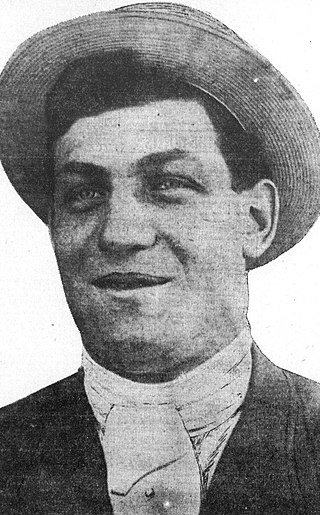
Al Kaufman was an American boxer and film actor.
The Black Heavyweight Championship was a title in pretense claimed by the African American boxer Klondike, who was born John Haines or John W. Haynes and by two-time colored heavyweight champ Frank Childs.
References
- ↑ "White Hopes -- 1908-1915". Cyber Boxing Zone Encyclopedia.
- ↑ Acevedo, Carlos. "Nasty, Brutish, Short: Al Palzer & The White Hopes". Boxing Insider. Retrieved 5 June 2012.
- ↑ "Arthur Pelkey vs. Luther McCarty". BoxRec. Retrieved 26 May 2012.
- ↑ "Georges Carpentier - Record". BoxRec. Retrieved 26 May 2012.
- ↑ 1634–1699: McCusker, J. J. (1997). How Much Is That in Real Money? A Historical Price Index for Use as a Deflator of Money Values in the Economy of the United States: Addenda et Corrigenda (PDF). American Antiquarian Society. 1700–1799: McCusker, J. J. (1992). How Much Is That in Real Money? A Historical Price Index for Use as a Deflator of Money Values in the Economy of the United States (PDF). American Antiquarian Society. 1800–present: Federal Reserve Bank of Minneapolis. "Consumer Price Index (estimate) 1800–" . Retrieved February 29, 2024.
- ↑ Marcus, Norman. "Gunboat Smith: "White Heavyweight Champion of the World"". Boxing.com. Retrieved 5 June 2012.